Lake Constance Part 1
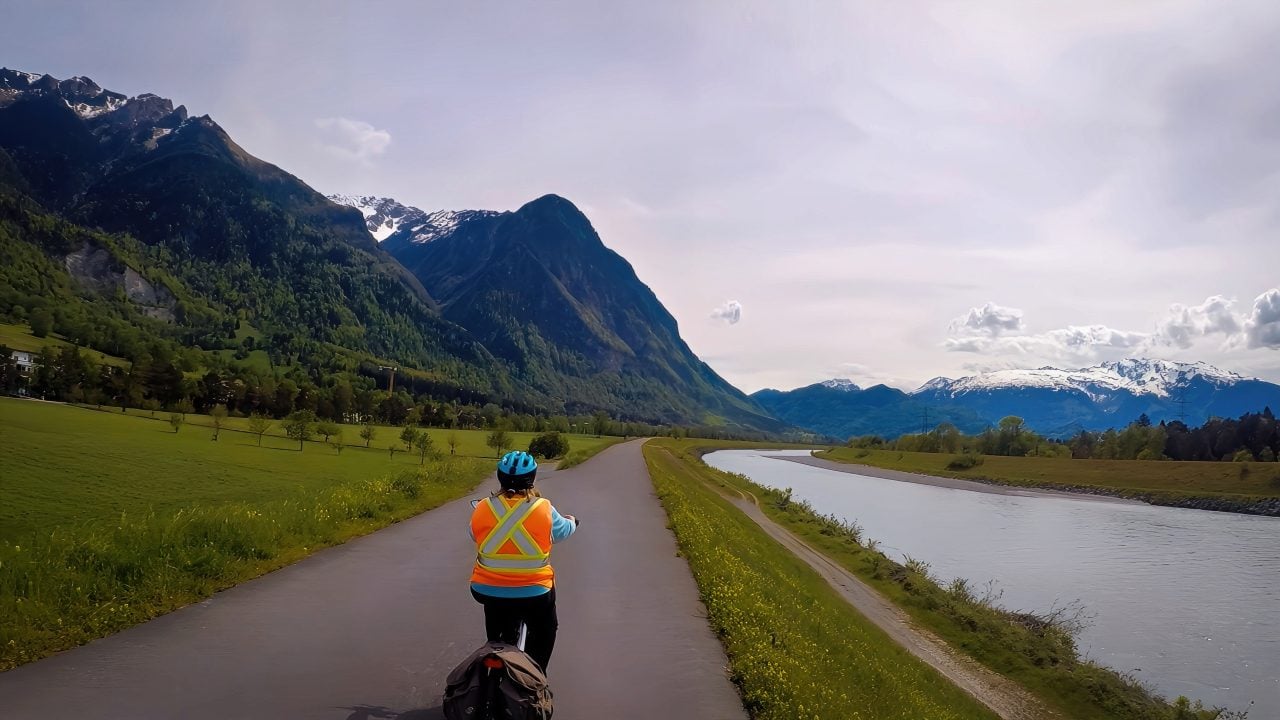
Mike and I have started our main e-bike ride for 2024. We hope to cycle from the start of the Rhine to where it empties into the North Sea. We actually decided to skip Milan and Lake Como so that we could get here and get started on this ride. Like we usually do, we are going to take this ride very slowly and explore along the way. We expect to stay on Lake Constance for about a month, 2 weeks at the far south-east end and then 2 weeks at the west end. There are lots of towns, villages, and larger cities to see.
Lake Constance’s shoreline is about 270 km long. Just over 60% of this is in Germany, about a quarter in Switzerland and Austria claims 10%. The lake sits at just under 400 metres (1300 ft) above sea level. Next to our campsite are 2 ponds right next to each other. The locals call them lakes. One is inside the campground we are staying in, and the other is not. The pond in our campground is in Switzerland, if you walk around to the other side of the campground fence you are at the pond in Austria.
In addition to the three countries that border Lake Constance, Liechtenstein is quite close by. Actually, Mike took the picture at the top of this article of me cycling in Liechtenstein on one leg of our cycling trip. Mike really wanted to camp in Liechtenstein just so that he could get a Liechtenstein sticker for our camper. As many of you know, we have stickers on the side of our RV of all the countries that we have camped in, in this RV. Although we visited Liechtenstein on an earlier trip and cycled from the north to the south this year, none of that qualifies for Mike to apply his Liechtenstein sticker. It is amazing how many people look at our stickers and ask about the countries that we have been to and they haven’t, or ask why we haven’t been to their home country.
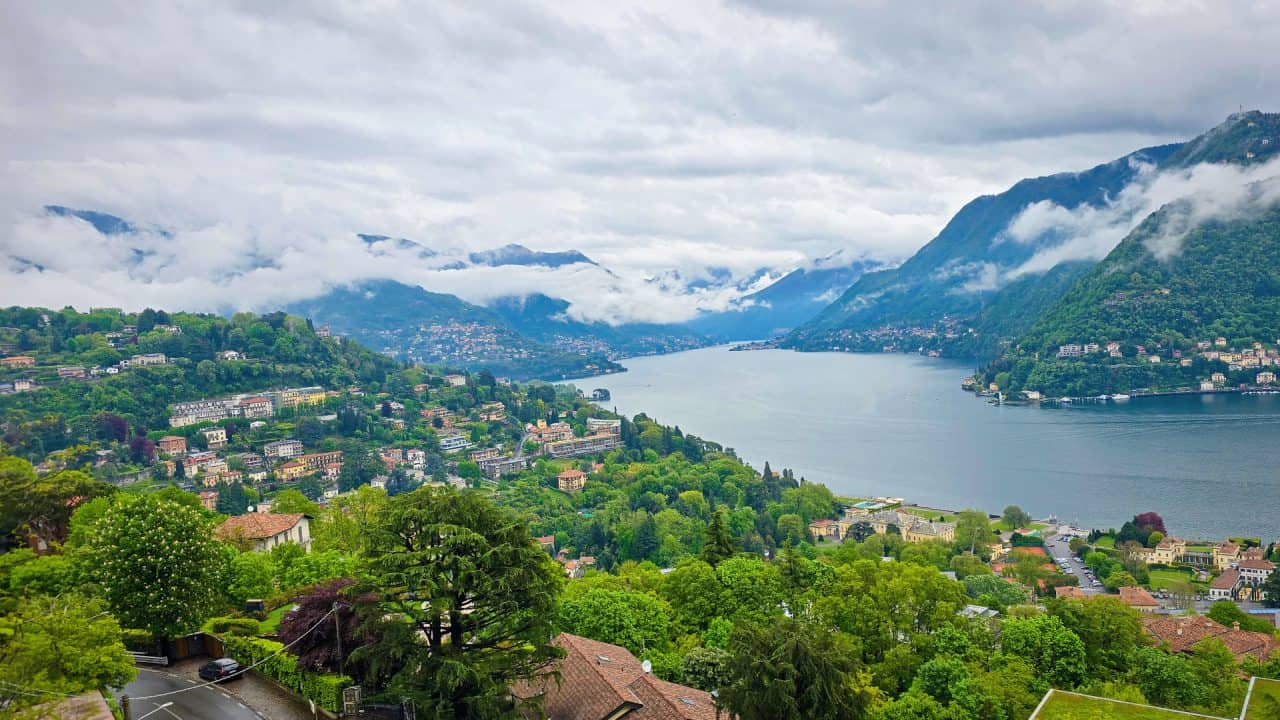
The picture here was taken from the RV as we passed above Lake Como on our way to Lake Constance.
I saw the name Bodensee on the lake on Google maps. I asked Gemini, Google’s AI tool, what did the Swiss call Lake Constance, what did the Germans call Lake Constance and what did the Austrians call Lake Constance. The answer was Bodensee, Bodensee, Bodensee. This name likely comes from the town of Bodman on the northwestern shore of the lake. How do the English speaking people get away with naming this lake after the city of Constance (which is also the English name for the city of Konstanz on the western shore of the lake). It just doesn’t seem right to me how all these places that we visit have names that would easily translate into English and yet the English speaking people had to invent new “non-native” names. The Italians have a city called Venezia that is now known, probably world-wide, as Venice thanks to the English speaking people around the world. It just seems wrong.
The drive to Lake Constance through the mountains was gorgeous. It was very long but you couldn’t beat the views. The drive took us over 1600m (>5,000 ft) high as we crossed the Swiss Alps. At one point there was both snow and clouds below us. We drove through some rain, which isn’t really great in a large RV in the mountains. We spent one full hour at the side of the road trying to purchase a pass that would allow us to drive the RV on the Swiss highways. The fines are really high if you are caught without the pass. We could not get our credit cards accepted by the app and the gas stations could only handle smaller cars. We called our credit card company and found out that all these attempts had actually put a hold on both our cards. At the end of all this, we still hadn’t managed to purchase the pass. Our drive that was supposed to be about five hours was turning into eight hours. I finally gave up and said that we just had to risk it. We weren’t getting anywhere and couldn’t delay any longer. As it turns out, we discovered the next day that the pass we had purchased last year, still had one month to run so we wasted a frustrating hour but saved a bit of money.
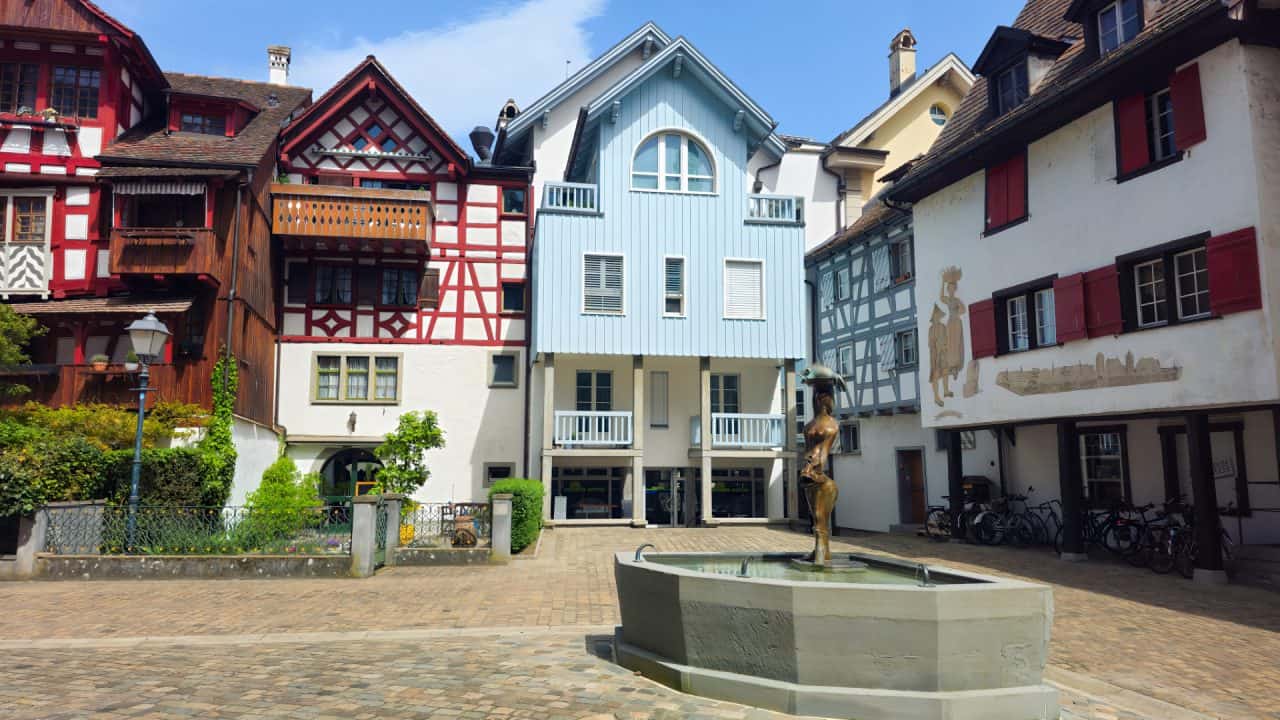
We find cycling quite interesting because it gives us something to do and we see all sorts of places that we probably wouldn’t visit by car. The larger picture just above is from the town of Arbon on the Swiss/south shore of Lake Constance. While cycling in a different direction we visited the town of Höchst in Austria. I really like seeing the sculptures everywhere in Europe. They don’t have to be of famous people. In Höchst I enjoyed just seeing this bench as we cycled by. It is much more interesting than most of our benches at home.
Mike and I had talked about cycling from the source of the Rhine to the delta on the North Sea. It turns out that the definition of the source isn’t that easy. There is a 0 km marker at the north-western end of Lake Constance but it is a bit of a misnomer. The marker is simply the place the Rhine exits Lake Constance. Maybe Germany just wanted to claim it was the source. The Rhine is formed from two separate streams/rivers, the Vorder Rhine and Hinter Rhine in Switzerland. These two sources converge near Chur forming the main Rhine River. Interestingly the Rhine flows through Lake Constance and remains identifiable as it continues its journey.
Mike and I will be staying in our current campground at the south-east end of the lake for another four days. So far we have cycled from the south end of Liechtenstein to Lake Constance and along the southern shore of the lake to where the Rhine exits to the west. We hope to get some good weather and to extend the “beginnings” of our path south of Liechtenstein to Chur.
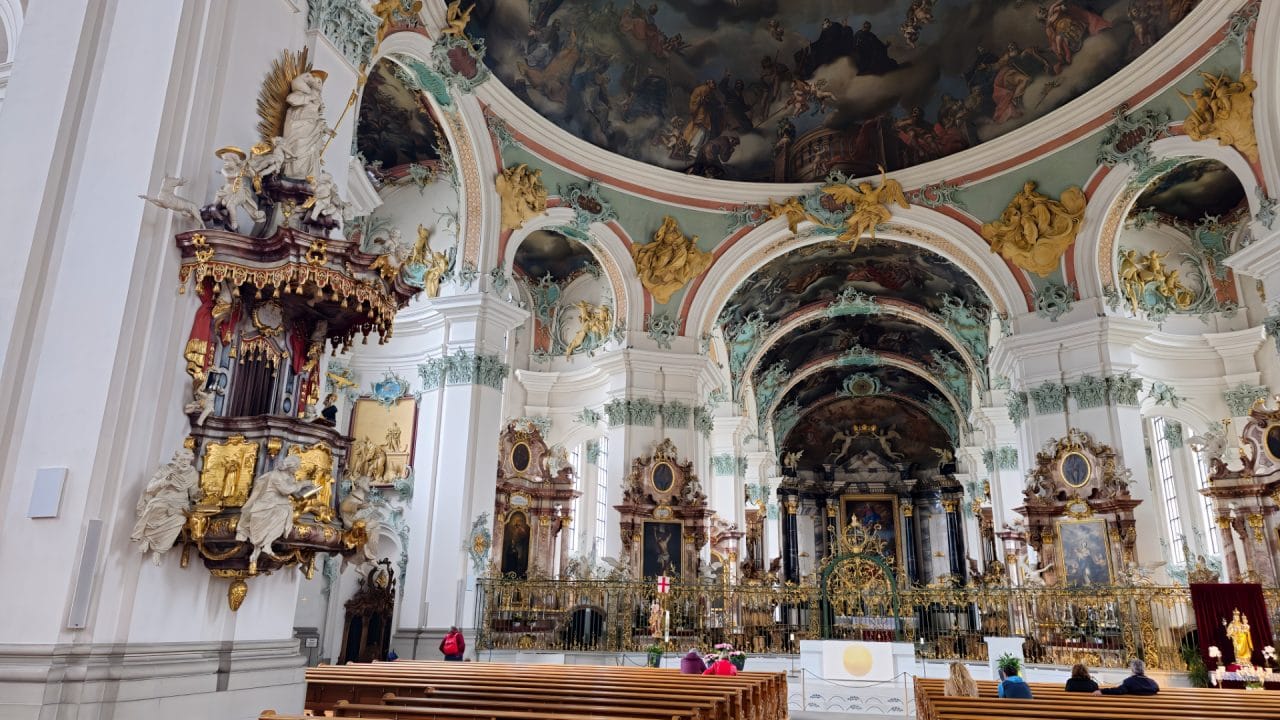
We don’t just cycle to places, we use our car as well. One day we drove to the nearby city of St. Gallen.
First let me tell you that Switzerland is expensive! Yes, this is something we all know but somehow, it is really hitting home this trip. Mike and I often cycle 30-40km in one direction and return on the train. Regional trains are quite inexpensive in Europe. We often pay about $15 Cdn for two adults and two bicycles. In Switzerland we are averaging $60-70 Cdn for the same ride. On the day we arrived, it was late, and we were quite tired. We drove to a McDonald’s just a couple of minutes from the campground. Our first meal in Switzerland, how lovely (NOT). Mike had a small size combo and I had one burger and nothing else. The cost – $50 Cdn. I decided that I was just going to have to ignore the all prices or I will never enjoy myself. I say that, but it doesn’t always work. Interestingly, in Italy we decided that there were more pizza and pasta restaurants (emphasis on pizza) than there were people. In Switzerland so far burgers seem more common.
The tourist bureau in St. Gallen did have a good deal. You could rent an audio guide of the town for 5 Swiss Francs. Since we couldn’t find a tour on our phones, we were happy to have this option. The idea was good but the descriptions of the various places were so long that it made me really tired before we even got to what St. Gallen is really known for and that is its Abbey.
Entering the Abbey’s attached church, pictured above, is free. To visit one room of the medieval library and two other rooms that we didn’t know what they were cost $60 Cdn. Was I ever surprised when Mike purchased the tickets. He said he was keen to see the library.
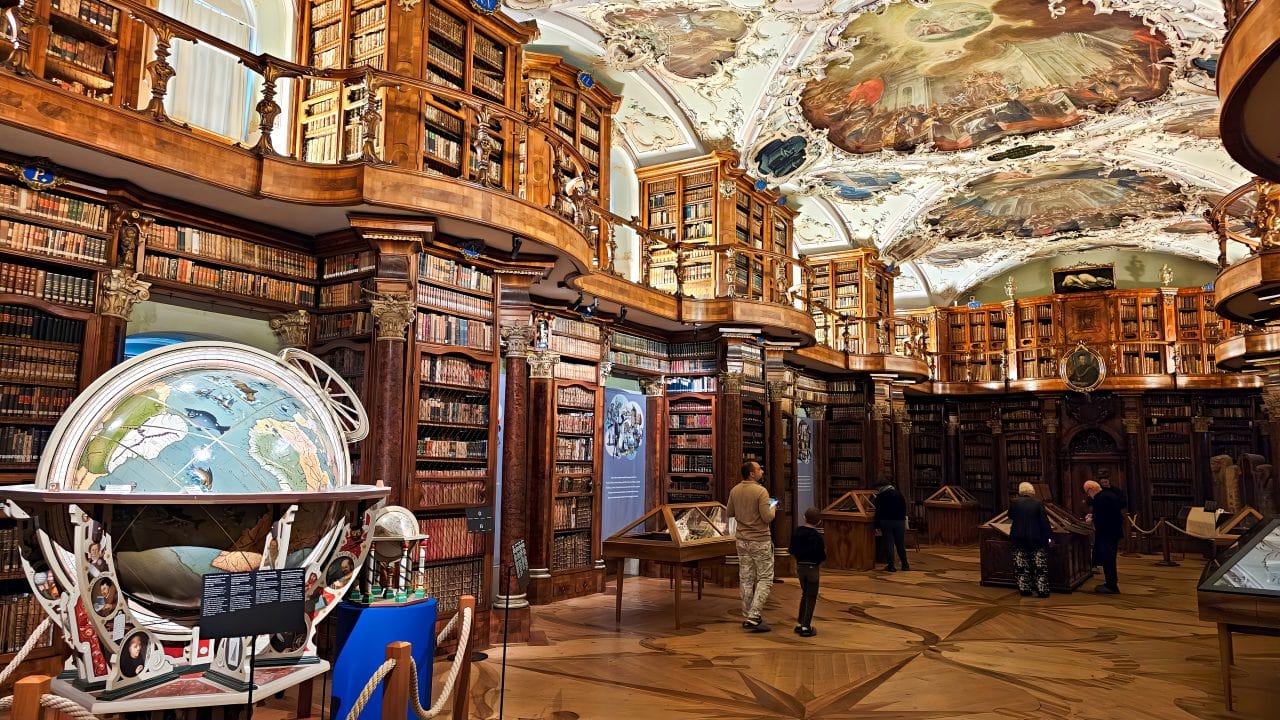
The Abbey Library of Saint Gall is considered to be one of the oldest and most beautiful libraries in the world. The heart of the library is the collection of early medieval manuscripts from the 8th to 11th centuries, which were largely created on site. Founded in the 8th century the library was a major center of learning during the Middle Ages.
The book shown is the Evangelium longum. It is an illuminated manuscript that was made around 894 in the Abbey. The front and back covers are made of ivory carvings surrounded by gold frame which were once owned by King Charlemagne. At a guess, the book itself was about 4″ thick with parchment pages.
Looking at all the books they had open in glass cabinets, it just brought home how every single book had to be hand-copied individually. What an effort. No wonder so few people could read or write. Gutenberg’s printing press has to be one of the top inventions of mankind.
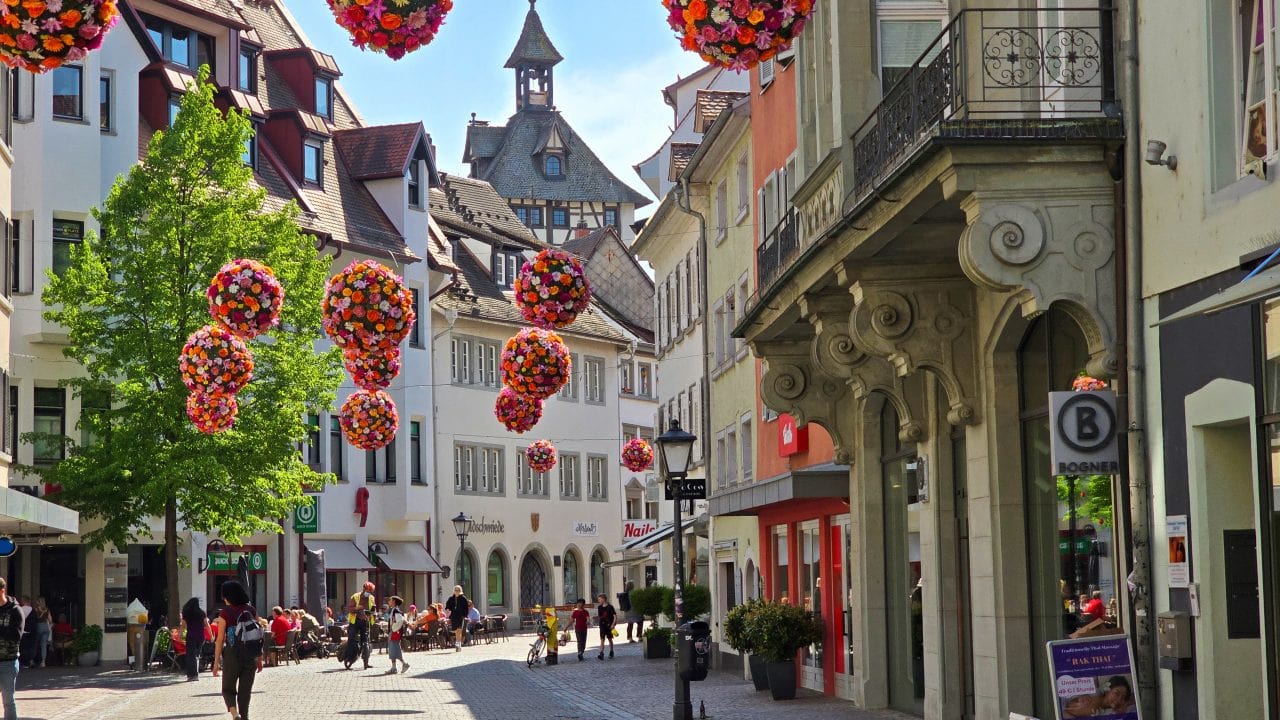
At the opposite end of the lake is the German city of Constance or Konstanz as it is known locally. Here we did have an audio guide tour on our phone and thoroughly enjoyed wandering around the city and seeing picturesque streets like the one above. We will probably be back when we move to our next campsite at this end of the lake.
Constance sits right on the lake and the views of Lake Constance are lovely. The Imperia statue in the picture is situated at the harbor entrance. It is a popular photo spot and a landmark. It is also probably one of the most controversial works of art in public space. Here is a description of the statue from the internet. “On a pedestal, rises a 9 m (30 ft) high, 18 tons heavy, concrete-cast figure of a woman dressed only sparsely in a fool cap on her head. She carries two naked male figures on her spread-out arms. In one hand, with his legs crossed, sits a figure with the papal tiara, in the other hand, with his legs spread, a figure with an imperial crown holding an orb in his hand. The female figure stands on a round table that rotates once in four minutes. It was erected in 1993.” I will admit that it was an extremely unusual statue.
I called this posting Lake Constance Part 1 because, if we are staying here for a full month you will have to put up with one or possibly even two more postings depending on the weather and the photo opportunities that we have. Look for Part 2 in about 10 days.

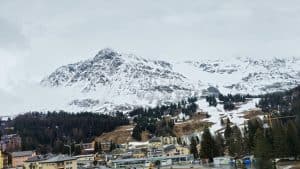
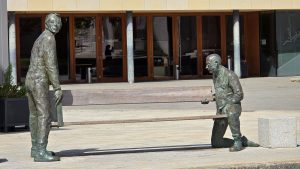
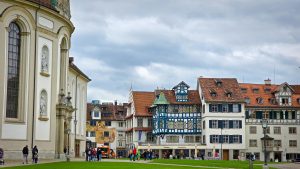
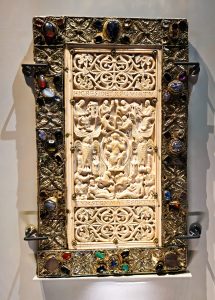
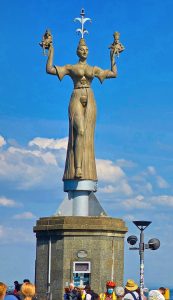
Leave a Reply